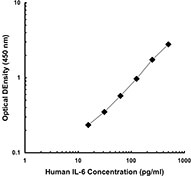- Regulatory Status
- RUO
- Other Names
- Interleukin-10, B-TCGF, CSIF, TGIF
- Ave. Rating
- Submit a Review
- Product Citations
- publications
IL-10 was first described as a cytokine that is produced by T helper 2 (Th2) cell clones. It inhibits interferon (IFN)-γ synthesis in Th1 cell, and therefore it was initially called cytokine synthesis inhibiting factor (CSIF). Macrophages are the main source of IL-10 and its secretion can be stimulated by endotoxin (via Toll-like receptor 4, NF-κB dependent), tumor necrosis factor TNF-α (via TNF receptor p55, NF-κB-dependent), catecholamines, and IL-1. IL-10 controls inflammatory processes by suppressing the expression of proinflammatory cytokines, chemokines, adhesion molecules, as well as antigen-presenting and costimulatory molecules in monocytes/macrophages, neutrophils, and T cells. IL-10 inhibits the production of proinflammatory mediators by monocytes and macrophages such as endotoxin- and IFN-γ-induced release of IL-1α, IL-6, IL-8, G-CSF, GM-CSF, and TNF-α. In addition, it enhances the production of anti-inflammatory mediators such as IL-1RA and soluble TNFα receptors. IL-10 inhibits the capacity of monocytes and macrophages to present antigen to T cells. This is realized by down-regulation of constitutive and IFNγ-induced cell surface levels of MHC class II, of costimulatory molecules such as CD86 and of some adhesion molecules such as CD58.
Product DetailsProduct Details
- Source
- Human IL-10, amino acids Ser19-Asn178 (Accession # NM_000572), was expressed in E. coli, approximately 18.8 kD
- Formulation
- Lyophilized in sterile-filtered PBS, pH 7.2, containing 1% BSA, 0.09% sodium azide, and protease inhibitors.
- Concentration
- Lot-specific (to obtain lot-specific concentration and expiration, please enter the lot number in our Certificate of Analysis online tool.)
- Storage & Handling
- Unopened vials can be stored between 2°C and 8°C until the expiration date. Prior to use, reconstitute the lyophilized powder with 0.2 mL of PBS containing a carrier protein (e.g., 1% BSA, protease free), pH7.4. Re-cap vial, vortex. Allow the reconstituted standard to sit at room temperature for 15 minutes, vortex again to mix completely. The reconstituted standard stock solution can be aliquoted into polypropylene vials and stored at -70°C for up to one month. Do not re-use diluted standards. Avoid repeated freeze/thaw cycles.
- Application
-
ELISA
- Recommended Usage
-
Each lot of this protein is quality control tested by ELISA assay. For use as an ELISA standard, a standard curve comprised of doubling dilutions from 500 pg/ml to 4 pg/ml is suggested. It is recommended that the reagent be titrated for optimal performance for each application.
- Application Notes
-
This IL-10 protein is useful as a standard for a human IL-10 sandwich ELISA, using purified JES3-9D7 antibody (Cat. No. 501402) or purified JES3-19F1 antibody (Cat. No. 506802) as for capture and biotinylated JES3-12G8 antibody (catalog #501502) for detection.
- Product Citations
-
Antigen Details
- Distribution
-
IL-10 is produce by Th2 cells, macrophages, DCs, B cells, CD8+ T cells, regulatory T cells (Tregs), Th1 cells and Th17 cells. In addition, IL-10 is expressed by monocytes, B cells, eosinophils, and mast cells.
- Function
- IL-10 is an immunoregulatory cytokine. Its main function is the limitation and termination of inflammatory responses and the regulation of differentiation and proliferation of several immune cells such as T cells, B cells, natural killer cells, antigen-presenting cells, mast cells, and granulocytes.
- Interaction
- IL-10R is expressed in monocytes, NK, B and T cells. In addition, Langerhans cells, dermal dendritic cells, eosinophils, mast cells, and endothelial cells can respond to IL-10.
- Ligand/Receptor
- IL-10 binds to their receptors IL-10R1 and IL-10R2, and initiates a STAT3-dependent signaling cascade.
- Biology Area
- Immunology
- Molecular Family
- Cytokines/Chemokines
- Antigen References
-
1. Fiorentino DF, et al. 1989. J Exp Med 170:2081.
2. Ho AS, et al. 1993. P. Natl. Acad. Sci. USA 90:11267.
3. Hart PH, et al. 1996. J Immunol 157:3672
4. Asadullah K, et al. 2003. Pharmacol Rev 55:241.
5. Mosser DM and Zhang X, et al.2008. Immunol Rev 226:205.
6. Maynard CL and Weaver CT, et al. 2008. Immunol Rev 226:219. - Gene ID
- 3586 View all products for this Gene ID
- UniProt
- View information about IL-10 on UniProt.org
Related FAQs
Customers Also Purchased


















Follow Us